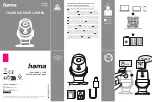
Appendix B: Trouble Shooting Guide
69
for imperfections such as dust, scratches, paper grain, etc. in the white reference. Once the white
reference is removed and the camera images the material to be inspected, any white reference
imperfections will appear as vertical stripes in the image. If the white reference had imperfections
that caused dark features, there will be a bright vertical line during normal imaging. Similarly,
bright features will cause dark lines. It can be very difficult to achieve a perfectly uniform, defect-
free white reference. The following two approaches can help in minimizing the effects of white
reference defects:
1.
Move the white reference closer to or further away from the object plane such that it is out
of focus. This can be effective if the illumination profile changes minimally when relocating
the white reference.
2.
If the white reference must be located at the object plane, then move the white reference in
the scan direction or sideways when flat field calibration is being performed. The camera
averages several thousand lines when capturing calibration reference images so any small
imperfections are averaged out.
3.
Use the cameras flat field calibration filter feature, as detailed in the user manual Flat Field
Calibration Filter section. This algorithm implements a low pass moving average that covers
several adjacent pixels. This filter can help minimize the effects of minor imperfections in
the white reference. Note: this filter is NOT USED in normal imaging.
Over Time, Pixels Developing Low Response
When flat field calibration is performed using a white reference, as per the guidelines in the user
manual, all pixels should achieve the same response. However, over time dust in the lens
extension tube may migrate to the sensor surface and reduce the response of some pixels.
If the dust particles are small, they may have only a minor effect on responsivity, but still create
vertical dark lines that interfere with defect detection and that need to be corrected.
Because repeating the flat field calibration with a white reference may not be practical while the
camera installed in the system, the camera has a feature where the flat field coefficients can be
downloaded to the host PC and adjusted using a suitable application, such as Microsoft Excel. (See
section Setting Custom Flat Field Coefficients for details.)
If the location of the pixel returning a low response can be identified from the image, then the
correction coefficient of that pixel can be adjusted, saved as a new file, and then uploaded to the
camera; thereby correcting the image without performing a flat field calibration.
See the user manual for details on downloading and uploading camera files using CamExpert.
Note that dust accumulation on the lens will not cause vertical lines. However, a heavy
accumulation of dust on the lens will eventually degrade the camera’s responsivity and focus
quality.
Smeared & Distorted Images
To achieve a well-defined image, the multiple lines are summed together and delayed in a manner
that matches the motion of the image across the sensor.
This synchronization is achieved by sending an external synchronization (EXSYNC) signal to the
camera, where one pulse is generated when the object moves by the size of one object pixel. See
‘External Trigger Mode’ in the user manual.
Содержание Linea HS Series
Страница 5: ...The Linea HS Monochrome Cameras 5 DECLARATION OF CONFORMITY 73 DOCUMENT REVISION HISTORY 74...
Страница 13: ...The Linea HS Monochrome Cameras 13 Responsivity QE Plots Note values measured using 8 bit 1x gain main array...
Страница 14: ...14 The Linea HS Monochrome Cameras Mechanical Drawings Figure 3 HL FM 08K30H 00 R Mechanical Drawing...
Страница 15: ...The Linea HS Monochrome Cameras 15 Figure 4 HL HM 16K30H 00 R Mechanical Drawing...
Страница 26: ...26 Camera Performance and Features Figure 7 Image with incorrect scan direction...
Страница 73: ...Declaration of Conformity 73 Declaration of Conformity...






































